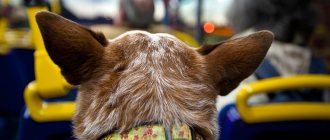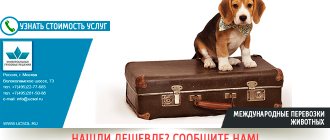Hello, dear readers! When going on vacation, dog owners are faced with a dilemma: take the animal with them or leave it at home. There are times when you don't have to choose. Travel with your pet; there is nothing wrong with transporting dogs on the train, especially since the rules have been significantly simplified in 2022.
In this article I will tell you how to take a dog on a train in Russia. I will not touch on the conditions for traveling with an animal abroad. But keep in mind that for each country, the set of documents may be different.
General principles for all directions and animals
- Animals can only be transported in places designated for this purpose. Below is a table with detailed conditions. You and your animals will not be allowed into other carriages or other seats.
- You can pay for the transportation of an animal on the train at the station before the train departs. From January 10, 2022, a veterinary certificate is no longer required to transport animals.
- Only pets can be carried in passenger carriages. Wild animals, bees, etc. transported in the baggage car of the same train in which the accompanying person is traveling.
- You must feed the animals yourself. Make sure that they do not spoil the sanitary and hygienic conditions in the carriage, too.
- The carry-on baggage allowance per passenger does not include animals. The rules apply both on trains owned by Russian Railways and on others.
- When traveling abroad by rail, be sure to check the conditions for importing animals into a specific country. Vaccinations, documents, the need for microchipping, types of pets allowed for import, etc. vary greatly.
- Blind passengers carry guide dogs with them free of charge in carriages of all categories; no registration is required. The dog must be at the feet of the passenger it is accompanying. When traveling abroad, it is better to check the conditions separately.
Required documents
Despite the simplification of the regime for transporting dogs, it is better to prepare some documentation, especially taking into account the fact that the number of required papers has significantly decreased.
Accompanying papers
Veterinary certificates are required only when changing the owner of an animal. The main document for the duration of a trip across the territory of the Russian Federation becomes a travel ticket. No other papers need to be presented.
Watch the video: “Documents for transporting dogs.”
An exceptional case is if the animal is used for profit (entrepreneurial activity). Therefore, it is necessary to have a complete package of accompanying documents with you.
The main document for an animal in such a situation is a veterinary certificate, issued after examination in a licensed clinic. Due to the short validity period of the document, it must be issued immediately before the trip.
Sanitary conditions
Russian Railways gives a fairly detailed description of the transportation container, ensuring compliance with sanitary standards.
Carrying should:
- be spacious enough for the dog;
- lock securely;
- well ventilated;
- have a dense bottom without holes, covered with hygienic filler.
If the general rules are followed, the handler will not require certificates of vaccinations, since they are only needed to bring the dog into the territory of other countries.
In which classes of carriages can animals be transported?
The table shows data on the carriages of JSC FPC - most Russian trains consist of them. About other trains - further in the text.
| Car type | Class of service (indicated on the ticket) | Conditions for transporting animals in a carriage |
| Lux | 1A, 1I, 1M | Regardless of how many people are traveling in the compartment. You can carry 1 container with small pets. For free. |
| SV (single) | 1B | You can carry 1 container with small pets or 1 large dog. For free. |
| SV in "Strizhi" | 1E | The coupe is being purchased in its entirety. You can bring a container with small pets free of charge. |
| NE | 1E, 1U, 1L, 1F | You can carry 1 container with small pets or 1 large dog. We need to buy all the seats in the compartment. There is no additional charge for transporting an animal. |
| Coupe | 2E, 2B, 2F, 2C | You can carry 1 large dog or a container with small pets. We need to buy all the seats in the compartment. There is no additional charge for transporting animals. |
| Coupe | 2L, 2K, 2U, 2N | If you are bringing small pets, you do not need to buy all the seats; one ticket + payment for transportation of animals is enough. If you are traveling with large dogs, you need to buy the entire compartment. If the number of passengers + dogs + containers with small animals does not exceed the number of seats in the compartment, you do not need to pay for the carriage of dogs. If you have more in total, you have to pay for the “extra”. |
| Econom-class train | 3U, 3D, 3B | You can travel with small pets (pay for pet transportation at the ticket office). Large dogs are not allowed. |
| Seat carriage | 1B, 1J | You can bring a container with small pets free of charge. Large dogs are not allowed. |
| Seat carriage | 2B, 2ZH, 3ZH | Small pets are allowed (one container per passenger ticket, no more than two animals per container) - you must pay for transportation at the ticket office. Large dogs cannot be transported. |
| General carriage | 3O | You can travel with small pets, but not with large dogs. Additionally, you don’t need to buy additional space for animals, but you do need to pay for their transportation at the ticket office at the station. |
In carriages of classes 1T, 1X, 1D, 1R, 1C, 2T, 2X, 2D, 2R, 2C, 2E, 2M, 3E, 3T, 3L, 3P, 3R, 3S, 3B (except for high-speed trains), animals cannot be transported.
In the carriages of TKS JSC, the rules for transporting animals are somewhat different from the general rules:
- Animals cannot be transported in reserved seat carriages (service class 3U Standard).
- Pets are not allowed in class 2T carriages.
- In compartment cars (2L, 2U Comfort) - you can. There is no need to buy all the seats in the compartment. For one passenger ticket - no more than 1 carrier (cage, basket, etc.), which contains no more than 2 small animals. Carrying dimensions and transportation rules are the same as on other trains. The transportation of animals can be arranged with the carriage conductors immediately before the train departs.
- In the SV (class 1B Business TC) you can transport animals, but you must buy all the seats in the compartment (in the sleeping car the compartments are double). The rules of transportation are similar to the general rules; there is no additional cost for transporting animals.
- Large dogs can only be transported in a compartment (class 2U, 2L), and the entire compartment must be purchased. There is no need to pay separately for animals. The number of dogs + the number of people accompanying them should not exceed the number of seats in the compartment (there are 4 of them).
general information
- Transportation rules in Russia depend on the size of the dog and the category of the train.
- The categories of “large” or “small” dog are determined based on the weight of the pet. “Small” dogs include dogs weighing no more than 20 kg.
- Tickets can be purchased for any category of pets at the railway ticket office.
- Documents and certificates from veterinary hospitals for small dogs are no longer required. The new rule was introduced in January 2022. You can read more here.
- Feeding and caring for a four-legged friend on the go is the responsibility of the owner. The owner himself ensures compliance with sanitary and hygienic standards and conditions and does not allow damage to Russian Railways property.
- Guide dogs travel free of charge without any special documents or certificates, together with the owner, muzzled and on a leash; they must be located next to the feet of the person who is carrying them.
Rules for transporting small pets on trains
- The animal must be in a basket or cage, container or carrier of adequate size (so that the pet is comfortable, but at the same time the container can be placed in the hand luggage areas in the carriage).
- The size of the container should not be more than 180 cm in the sum of three dimensions (length + width + height).
- No more than two small animals or two birds in one container (cage, basket, carrier, etc.).
- No more than 1 container of animals per passenger ticket, unless otherwise specified in the table above for your type of carriage.
Useful tips
Remember that traveling on a train is very stressful for an animal; its behavior and condition can change dramatically. To ensure your trip goes smoothly, consider the following tips:
- Buy special sedatives for dogs, they come in tablets or drops. Start giving them a week before departure, the medications have a cumulative effect.
- The last meal should be no later than the day before departure. On the train there is a high risk of motion sickness, the dog may vomit, and in general it will feel bad with a full stomach. It is important to take more drinking water.
- Don't forget to walk your pet right before boarding. There are no conditions in the carriage for animals, and it will be hard for them to endure “what’s left.” Buy special dog diapers that can be placed in the bottom of the carrier.
- Be sure to purchase a comfortable muzzle. He must be free, the tailed friend must be able to open his mouth easily and wide. The carriages are usually very stuffy, plus the pet is nervous. Do not use narrow cloth muzzles.
- Choose daytime for your trip, as it is more difficult to monitor the animal at night. And it is advisable that the duration of the trip is no more than a day. If the distance is too long, it is better to buy a plane ticket. To learn how to prepare for a flight, read the article “What documents are needed to transport a dog on an airplane?”
How to take animals abroad
- Ukraine and Belarus: animals can only be transported in a compartment; it must be purchased in its entirety. Animals up to 20 kg - in cages (baskets, containers, boxes) in all carriages, except for SV and catering carriages, payment is the same as for 20 kg of luggage. Large dogs - in a separate compartment, no more than one dog (unlike domestic trains!), the entire compartment is paid for.
- Europe: if you are traveling not only by Russian trains, read the rules of the carriers whose services you are going to use. There may be nuances. Special conditions may apply on night trains. General principles: small animals are carried in suitable means as hand luggage, free of charge. Dogs are muzzled and on a leash. It is better to check the types of carriages in which dogs can be transported separately for a specific train and direction. The conditions of transportation are the same (you may need to buy back the entire compartment, but on preferential terms).
- UK and Norway: import/export of pets is prohibited.
- China, Mongolia, North Korea, Vietnam: you can only bring pets with you. It is allowed to travel only in 2nd class carriages (compartments), no more than two animals per compartment, all seats are purchased. Tickets for dogs are half the price of tickets for people.
- Finland. You can take with you no more than two dogs (each on a leash) or two cages with small animals (the size of each cage is no more than 60x45x40 cm). Or you can bring one dog and one crate. The veterinary certificate for each animal must be in Russian + one of the following: Finnish, Swedish or English (a sample can be found on the EVIRA website). It must be in the officially accepted form in the EU countries. Vaccination notes made in animal passports of European Community countries are also suitable and sufficient for transportation. Russian animal passports are not suitable. Animals can only be transported in a compartment carriage; all seats in the compartment must be bathed. In Allegro, you can travel with animals only in special seats 65-68 in carriage No. 6. Tickets for these seats cost 15 euros more, even if you are traveling without a pet. Guide dogs are free, but they are only allowed on 2nd class carriages. On the Leo Tolstoy train you also need to buy tickets for all seats in the compartment. Guide dogs accompanying disabled people are transported only in 2nd class carriages, free of charge.
The rules are given for trains formed by JSC FPC (most Russian trains). For other carriers they may differ, but only slightly. The information is for reference only. We recommend checking this with the carrier before traveling. For example, in the Russian Railways help desk by phone 8-800-775-00-00 (the call is free throughout Russia).
Have a nice trip!
About the cost
Starting from January 2022, Russian Railways is increasing the price for the transportation of small animals in reserved seats and long-distance seated carriages. A list of tariff zones with updated prices is available on the carrier’s official website. The minimum cost (for distances up to 10 km) is 268 rubles.
The combination of a number of factors will determine how much the ticket ultimately costs. For example, transporting a large dog may require payment for all remaining seats in the compartment - the difference from the situation when the last unoccupied seat is purchased is significant. The absence of an additional fee does not play a big role.
Note: It is good practice to look for travel companions with pets. This can be done in advance, on thematic forums or in social network groups.
If the trip has been planned for a long time, you can find travelers who also plan to bring animals with them. In this case, the problem of buying out all the places and possible conflicts with neighbors disappears.
Watch the video: “How to guide your dog on a train.”
Do you need a ticket?
You will have to buy a ticket in all cases unless otherwise stated - this is a general condition for transporting small animals during railway travel. Therefore, you should once again check the list of cars and their classification.
The need for a ticket is indicated for each individually. If the number of animals transported exceeds the stipulated norms, then in addition to the ticket you will have to buy an additional seat.
Condition of the cat after transportation
After the move, the animal, of course, continues to experience stress. This happens not only because of the transportation itself, but also because the animal ends up in a completely new place for it, in a new apartment.
Basically, the behavior of the animal is as follows:
- refusal to eat for several days (1-3 days);
- refusal to go to the toilet (up to 24 hours after moving);
- the animal does not make contact with the owner, hides under the sofa or in another secluded place.
After 2-3 days, this condition passes and the cat begins to behave as usual. After a week, Mars had already completely settled down - his appetite returned, he began to go to the litter box and behave like the master of the house.
Trip abroad
Don’t forget, the above rules are typical for Russian railway transport. If you travel abroad by train, you need to familiarize yourself with the rules of the country you will find yourself in. Not sure about local regulations? Here are a few tips that may be unnecessary, but will help you save your nerves when traveling to any country. Better to be on the safe side, follow these steps before leaving:
- Get the necessary vaccinations and include them in your passport.
- Keep documents with you in an accessible but safe place.
- Receive a veterinary certificate (Form No. 5a is required) with the prescribed points of all possible transplants, no earlier than 5 days before departure. If the trip is planned there and back, save it until you return to Russia.
- Have your pet microchipped just in case.
In many countries, any pet must be microchipped.
A special carrier is best suited for railway transport
Video
And in this video, Jack and I talk about the rules for transporting dogs on Russian Railways trains around the country. We share our experience and tell you what “surprises” may await you on the road!
Don't forget to like, Jack and I will be very pleased!
This is how we traveled with Jack on a Russian Railways train and a little on a regular intercity bus. At first it seemed that our path would not be easy and thorny, but in fact everything turned out to be not so scary and quite comfortable. If you have any questions, ask in the comments, I will try to answer.










